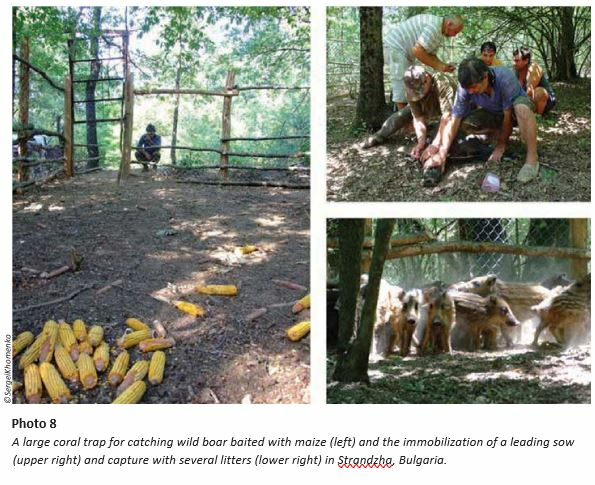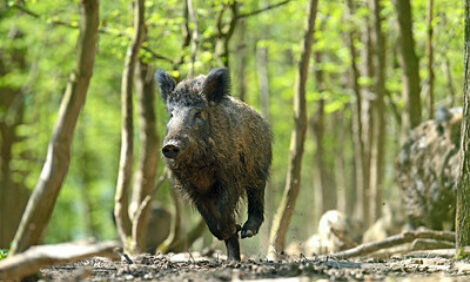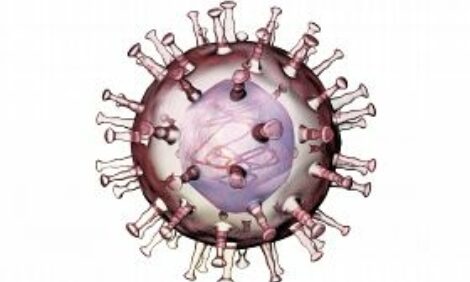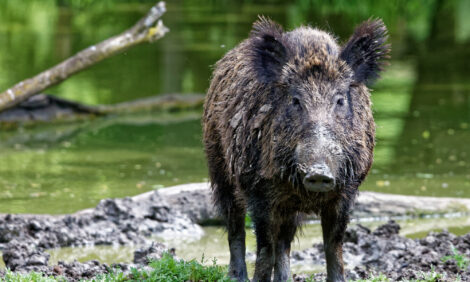



African swine fever in wild boar: trapping
Mobile traps or cages can help in residential areas, public spacesEditor's note: the following is an excerpt from African swine fever in wild boar populations - ecology and biosecurity. It was created by the FAO, WOAH and European Commission. Additional content from the booklet will be shared as an article series.
Operations in ASF-affected areas require the same biosecurity measures as during normal hunting, but could be easier to ensure due to the limited surfaces of contaminated areas and involved personnel. Logistical arrangements should account for the fact that a proportion (up to 7 percent, or possibly more for an infected family group) of captured animals could have a subclinical infection. Precautionary biosecurity measures must therefore be developed and strictly adhered to during trapping campaigns to avoid the spread of ASF between trapping locations and its introduction to domestic pigs. Practical ways to euthanize, transport, keep and, when needed, destroy carcasses that are ASF-positive must be considered.
Catching wild boar with mobile traps or cages can help in residential areas and public parks where no other population control option is available. The successful application of wild boar trapping as part of a disease management strategy was demonstrated in small CSF-affected populations in Bulgaria (Alexandrov et al., 2011) and Belgium where trapping contributed up to 24 percent of the depopulation approaches (Licoppe et al., 2020). Finally, fencing in (or close to) affected areas reduces escape movements of wild boar, which are one of the main challenges faced when implementing driven hunts.
Increase in overall hunting pressure. A general increase in hunting rates is recommended and/or officially prescribed to hunting associations as a primary wild boar population control approach. Though wild boar hunting bags have been growing throughout Europe, these cannot compensate for the population increases (Massei et al., 2015; Vetter et al., 2015). Despite bigger hunting bags, there have been indications in recent decades that the number of hunters in many European countries is steadily declining, along with the overall interest in wild boar hunting. Furthermore, research suggests that under these conditions in central Europe, the removal of up to 80 percent of wild boar piglets will be needed to keep populations stable (Bieber and Ruf, 2005). This figure could be slightly lower for more continental wild boar populations, such as those in eastern Europe, but this result can be rarely achieved in practice.
Where feasible, a general increase in hunting bags can be a strategy to control populations, though it is usually difficult to significantly increase hunting pressure without deploying more effective or destructive hunting methods, such as driven hunts, killing from helicopters or use of mounted night vision equipment to facilitate the location of game. Intensifying driven hunts is only possible to a certain extent, after which the dispersion and redistribution of animals are inevitable. In some areas, driven hunts can be organized in a way that reduces the risk of dispersion, provided that the hunt is performed over a very large area with many different hunters, hunting clubs and landowners involved, though this approach increases the cost and time required to achieve success. As population densities decline, encountering and hunting animals also becomes more difficult and time-consuming for hunters, regardless of the approach used.
Aerial hunting within temperate forest and forest steppe areas that have a moderate-to-high human population is problematic due to the dense foliage and danger it poses to humans. Hunting with night vision equipment is regulated in many European countries. Under environmental conditions of temperate European forests, the extension of the hunting season beyond colder months does not always lead to increased hunting bags. In spring months, wild boar become difficult to track due to farrowing, with green foliage during this season strongly complicating their location.
In some countries, the army or other armed corps have been involved in hunting. Aside from legal constraints, it is clear that intense actions limited by time and space are less effective than continuous coordinated efforts carried out across large geographical areas when the abundance of wild boar is decreasing. Experience from Czechia has shown that even if professional snipers are involved in a hunt, their knowledge of the area and wild boar habits are critically important for hunting success. In Belgium, trained local forest officers combined their knowledge of the area and used night vision equipment and baiting sites with Global System for Mobile Communications (GSM) camera traps to successfully cull the last surviving wild boar in the infected area.
In general, the increase in hunting pressure using conventional recreational hunting methods can only succeed as a population control approach for stable or slowly-increasing populations. Unconventional hunting involving armed forces and special troops is not likely to help with extensive long-term population control programmes, as these require sustained systematic efforts and a mix of locally applicable measures.
Wild boar poisoning. The application of poisonous substances as a means of radically increasing the mortality of wild boar has been proposed in several ASF-affected countries as a potential, and seemingly very attractive, population control solution. These considerations are fuelled by attempts in other countries to apply biocides as a way to manage overabundant populations, such as feral pigs in Australia or wild boar as an invasive species in the United States of America. At present, poisoning is legally prohibited in all northern and eastern European countries.
In European Union countries, for example, the use of biocides is strictly regulated (Regulation (EU) No. 528/2012). The regulation places several restrictions on the use of any biocide outside of its authorized purposes and means of distribution. Though derogations to the law can be obtained (art. 55), it is very difficult to minimize all the risks posed by the intensive, large-scale use of biocides in natural conditions.
Aside from the ethical aspect of the approach, a specific plan should be designed outlining motivation, feasibility, probability of success and risk factors linked to the operations. Any possible risk should be clearly considered and minimized. A lack of data and experience would make any attempt to poison wild boar a hazard, as the risks are currently very difficult to evaluate and manage. Currently, it is not possible to promptly design and implement an effective and safe large-scale wild boar poisoning programme in any of the European countries.
Any biocide aimed at poisoning wild boar in the natural environment should fulfil a number of criteria to become legalized, officially accepted and practically applied in population control programmes. The substance used should be species specific to ensure that only the targeted species is killed, without any secondary or accidental poisoning of non-target species, such as brown bears, wolves or birds. It should also be highly attractive to wild boar and easily accepted by them. An effective antidote should be available both for humans and domestic animals in case of its large-scale application. The biocide must cause minimal pain and suffering to the animals after consumption and must be sufficiently safe for people involved in the field operations. Its complete and safe degradation in the environment, including soil, ground and surface water, and invertebrate biocenosis, should also be guaranteed. The poison itself, as well as its distribution and delivery systems to the target species, should all be reasonably priced so that they can be used repeatedly on large spatial scales to achieve a sufficient long-term reduction of target species populations.
Practical experience with the application of several biocides for the control of wildlife populations is available from the Americas and Oceania (Cowled et al., 2008). In those areas, warfarin, phosphorus, sodium fluoroacetate (1080) and sodium nitrite were the most used. Both warfarin and phosphorus failed to meet welfare requirements and were abandoned. The environmental risk linked with 1080, particularly in terms of secondary poisoning of non-target species, was also unacceptable. Nitrites were shown to be the least dangerous of the options and were capable of fulfilling some of the requirements. In addition to the choice of an effective and safe poison, the implementation of largescale wild boar control programmes using biocides in northern and eastern European countries will likely face many known and unknown challenges

Any type of poison will need to be incorporated into baits ingestible by wild boar. Baits will always attract a large number of non-target species, particularly birds and mammals, which will vary depending on the type of environment, habitat and season. To prevent poisoning non-target species, baits should be delivered exclusively to wild boar using species-specific systems (see the section on contraception). Bait delivery devices have never been tested in areas inhibited by brown bears, bison, wolves or jackals, nor have they been used across a wider range of European environments and animal communities.
At least one bait delivery device should be used per every 300 hectares. At present, the area of ASF occurrence in wild boar populations is more than 300 000 km2, which implies the manual installation of a significant number of bait delivery devices (more than 70 000). This dramatically increases the probability of non-target species poisoning (including species with high conservation status), unpredictable involuntary accidents and environmental contamination. Due to the highly hierarchical social structure of wild boar family groups and the different mobility patterns of animals, depending on sex, age and season, it could be difficult to ensure that animals have an individual dose of poison, which is also the case for oral contraceptives. Other issues that should be considered include the persistence of poison in the food web chain and its accumulation in certain substrates.
Wildlife management and conservation challenges due to the spread of African swine fever
While most governments in Eurasia view ASF control as an important goal, the reality is that the disease is firmly establishing itself in the continental area’s ecosystems and gradually becoming part of ecological dynamics. Given then extent of the current ASF distribution in Eurasia, it is highly unlikely that the disease will fade out naturally in European ecosystems or be quickly and successfully eradicated from both domestic and wild pigs. This means that management of the species and ecosystem conservation should account for either a permanent or occasional presence of the pathogen and its potential role as a key mortality factor for wild boar.
While it is difficult to estimate overall ASF-related losses of the Eurasian wild boar population for 2008–2021, it is clear that wild boar numbers declined significantly in all areas where the disease was present. Multiple observations at managed hunting grounds in the Southern Federal District in the Russian Federation in 2007–2012 documented rapid local declines of wild boar populations shortly after the virus was found in the area (FAO, 2014). Mortality estimates ranged from 85–90 percent, which closely corresponded to observations made in Poland in 2012–2017 (Morelle et al., 2020). Whenever the disease finds sufficiently abundant wild boar it is likely to develop into a severe epidemic that results in population crashes and may be followed by an extended period of “tail” endemicity (see chapter 1).
At present, the nature conservation implications of the ASF expansion and the massive mortalities it produces among wild boar populations could be overshadowed by worries related to economic losses within the pork industry and threats to food security. Wild boar is a very important autochthonic species found in a wide range of habitats across the continent (Heptner, Nasimovich and Bannikov 1961; Danilkin, 2020). Its extermination should not be viewed as a major way to eradicate ASF (as highlighted in chapter 3), with game biologists and conservation scientists questioning the relevance and effectiveness of the species’ depopulation measures.
Nonetheless, in some countries, massive “depopulation” campaigns or official orders have already been implemented or issued to reduce wild boar numbers significantly (Danilkin, 2017, 2020). In some cases, plans or attempts were made to “replace” wild boar with exotic species of ungulates, such as white-tailed deer (Odocoileus virginianus; Danilkin, 2020). Such a replacement is itself an impossible task, since the ecological niche that wild boar occupy is rather specific and not suitable for any other ungulate species. Both the extermination of wild boar and introduction of exotic species are actions that clearly conflict national and international nature conservation legislation and can create a cascade of ecological implications, some of which are briefly described in this section. Problems stemming from such actions will depend on the local situation and context, but outcomes can be grouped around several main issues outlined below.
Guberti, V., Khomenko, S., Masiulis, M. & Kerba S. 2022. African swine fever in wild boar – Ecology and biosecurity. Second edition. Chapter 3. FAO Animal Production and Health Manual No. 28. Rome, FAO, World Organisation for Animal Health and European Commission. https://doi.org/10.4060/cc0785












